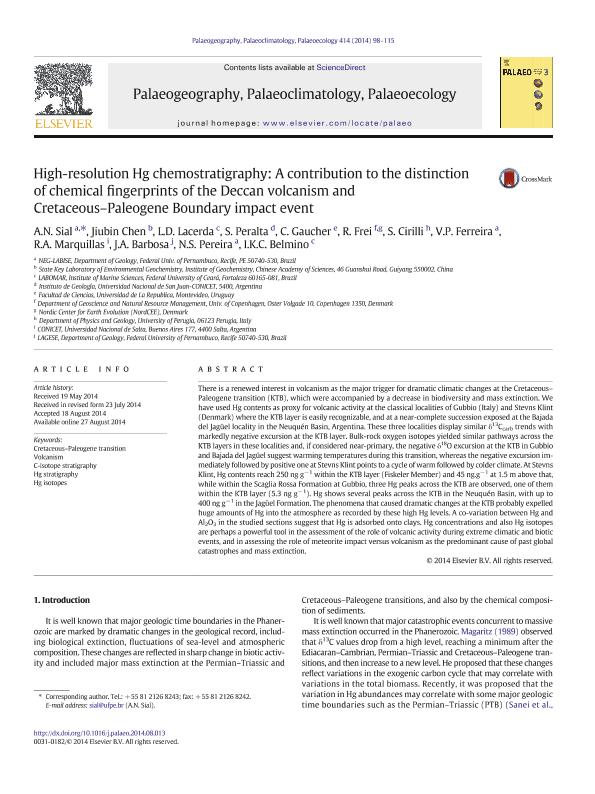Mostrar el registro sencillo del ítem
dc.contributor.author
Sial, A. N.
dc.contributor.author
Chen, Jiubin
dc.contributor.author
Lacerda, L. D.
dc.contributor.author
Peralta, Silvio Heriberto

dc.contributor.author
Gaucher, Claudio
dc.contributor.author
Frei, R.
dc.contributor.author
Cirilli, S.
dc.contributor.author
Ferreira, Valderez P.
dc.contributor.author
Marquillas, Rosa Argentina

dc.contributor.author
Barbosa, J. A.
dc.contributor.author
Pereira, N. S.
dc.contributor.author
Belmino, I. K. C.
dc.date.available
2016-03-30T16:25:43Z
dc.date.issued
2014-03
dc.identifier.citation
Sial, A. N.; Chen, Jiubin; Lacerda, L. D.; Peralta, Silvio Heriberto; Gaucher, Claudio; et al.; High-resolution Hg chemostratigraphy: A contribution to the distinction of chemical fingerprints of the Deccan volcanism and Cretaceous–Paleogene Boundary impact event; Elsevier; Palaeogeography, Palaeoclimatology, Palaeoecology; 414; 3-2014; 98-115
dc.identifier.issn
0031-0182
dc.identifier.uri
http://hdl.handle.net/11336/4970
dc.description.abstract
There is a renewed interest in volcanism as the major trigger for dramatic climatic changes at the Cretaceous–Paleogene transition (KTB), which were accompanied by a decrease in biodiversity and mass extinction. We have used Hg contents as proxy for volcanic activity at the classical localities of Gubbio (Italy) and Stevns Klint (Denmark) where the KTB layer is easily recognizable, and at a near-complete succession exposed at the Bajada del Jagüel locality in the Neuquén Basin, Argentina. These three localities display similar δ13Ccarb trends with markedly negative excursion at the KTB layer. Bulk-rock oxygen isotopes yielded similar pathways across the KTB layers in these localities and, if considered near-primary, the negative δ18O excursion at the KTB in Gubbio and Bajada del Jagüel suggest warming temperatures during this transition, whereas the negative excursion immediately followed by positive one at Stevns Klint points to a cycle of warm followed by colder climate. At Stevns Klint, Hg contents reach 250 ng g− 1 within the KTB layer (Fiskeler Member) and 45 ng.g− 1 at 1.5 m above that, while within the Scaglia Rossa Formation at Gubbio, three Hg peaks across the KTB are observed, one of them within the KTB layer (5.3 ng g− 1). Hg shows several peaks across the KTB in the Neuquén Basin, with up to 400 ng g− 1 in the Jagüel Formation. The phenomena that caused dramatic changes at the KTB probably expelled huge amounts of Hg into the atmosphere as recorded by these high Hg levels. A co-variation between Hg and Al2O3 in the studied sections suggest that Hg is adsorbed onto clays. Hg concentrations and also Hg isotopes are perhaps a powerful tool in the assessment of the role of volcanic activity during extreme climatic and biotic events, and in assessing the role of meteorite impact versus volcanism as the predominant cause of past global catastrophes and mass extinction.
dc.format
application/pdf
dc.language.iso
eng
dc.publisher
Elsevier

dc.rights
info:eu-repo/semantics/openAccess
dc.rights.uri
https://creativecommons.org/licenses/by-nc-nd/2.5/ar/
dc.subject
Cretaceous
dc.subject
Paleogene
dc.subject
C-Isotope
dc.subject
Hg-Isotope
dc.subject.classification
Geología

dc.subject.classification
Ciencias de la Tierra y relacionadas con el Medio Ambiente

dc.subject.classification
CIENCIAS NATURALES Y EXACTAS

dc.title
High-resolution Hg chemostratigraphy: A contribution to the distinction of chemical fingerprints of the Deccan volcanism and Cretaceous–Paleogene Boundary impact event
dc.type
info:eu-repo/semantics/article
dc.type
info:ar-repo/semantics/artículo
dc.type
info:eu-repo/semantics/publishedVersion
dc.date.updated
2016-05-06 15:52:43.262787-03
dc.journal.volume
414
dc.journal.pagination
98-115
dc.journal.pais
Países Bajos

dc.journal.ciudad
Amsterdam
dc.description.fil
Fil: Sial, A. N.. Universidade Federal Rural Pernambuco; Brasil
dc.description.fil
Fil: Chen, Jiubin. Chinese Academy Of Sciences; República de China
dc.description.fil
Fil: Lacerda, L. D.. Federal University of Ceará. Institute of Marine Sciences; Brasil
dc.description.fil
Fil: Peralta, Silvio Heriberto. Universidad Nacional de San Juan. Facultad de Ciencias Exactas, Fisicas y Naturales. Instituto de Geologia "Dr. Emiliano Aparicio"; Argentina. Consejo Nacional de Investigaciones Científicas y Técnicas. Centro Científico Tecnológico San Juan. Centro de Investigaciones de la Geosfera y Biosfera; Argentina
dc.description.fil
Fil: Gaucher, Claudio. Universidad de la Republica. Facultad de Química y Facultad de Ciencias; Uruguay
dc.description.fil
Fil: Frei, R.. University of Copenhagen. Department of Geoscience and Natural Resource Management; Dinamarca. Nordic Center for Earth Evolution; Dinamarca
dc.description.fil
Fil: Cirilli, S.. Università degli Studi di Perugia. Dipartimento di Fisica e Geologia; Italia
dc.description.fil
Fil: Ferreira, Valderez P.. Universidade Federal de Pernambuco; Brasil
dc.description.fil
Fil: Marquillas, Rosa Argentina. Universidad Nacional de Salta. Facultad de Ciencias Naturales. Cátedra de Geología Argentina y Sudamericana; Argentina
dc.description.fil
Fil: Barbosa, J. A.. Universidade Federal de Pernambuco; Brasil
dc.description.fil
Fil: Pereira, N. S.. Universidade Federal de Pernambuco; Brasil
dc.description.fil
Fil: Belmino, I. K. C. . Federal University of Ceará. Institute of Marine Sciences; Brasil
dc.journal.title
Palaeogeography, Palaeoclimatology, Palaeoecology

dc.relation.alternativeid
info:eu-repo/semantics/altIdentifier/url/http://www.sciencedirect.com/science/article/pii/S0031018214004106
dc.relation.alternativeid
info:eu-repo/semantics/altIdentifier/doi/http://dx.doi.org/10.1016/j.palaeo.2014.08.013
Archivos asociados
